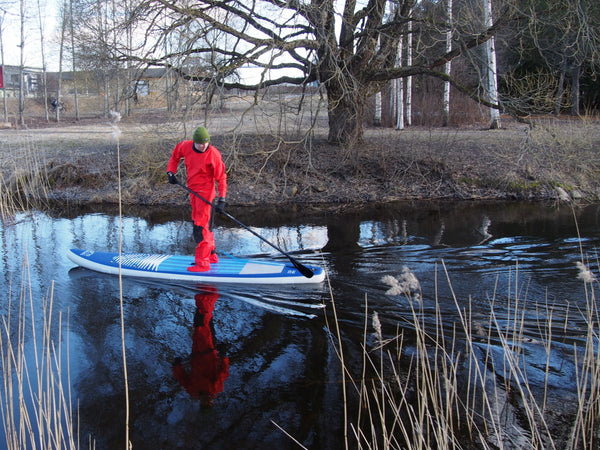Dry suit funnelling
Dry suit funnelling
I have been dreaming for a long time to try the opening of the funnel season with a dry suit. Even though I've gained experience over the years, paddling in the ice without any kind of suit adds a certain excitement to paddling. And anyway, I've been wondering how the dry suit really works in the water and if you keep the pace up while paddling, does it feel like a steamed-up naked man inside the suit?
For the test we chose Artistic's Air dry suit, which is the lighter and more affordable range of dry suits, and in my opinion the lightweight suit is the only option for sports where you are almost constantly in motion. Soup racing, or indeed any other more active sport with a thick and stiff suit, does not seem like a good idea. The material of this dry suit feels only slightly thicker than a normal shell jacket, for example. And the idea is actually to use the suit as a shell garment, so there is room underneath for underwear according to your own preference and the weather. On the day of the test it was about +3 degrees, occasional wind chill but otherwise the weather was beautiful and sunny. I wore normal sports shorts, a t-shirt and normal socks underneath.

In this Artistic Air drysuit, the zipper and dressing is done through the crotch, as it were; the suit has a long zipper that opens from one ankle through the crotch to the other ankle. A video of the dry suit being put on at the end of the article. But then the suit is put on, making sure the zipper is securely locked all the way to the bottom, the rubber wrist cuffs are fastened and the collar is in place. And off we go!

First of all I had to test "does it really hold water" and I recommend that to others for two reasons; of course it's important to make sure that the zipper is closed and if there's any damage to the fabric (if you manage to get a hole in the fabric, it's fixable, it comes with a small patch kit), but the other thing I didn't think about is the air that gets trapped inside the suit. So when you land from the sup board into the water, the air inside the drysuit will rise above the waterline and carry on the surface. This is something every user should try, even with a flotation vest if you wear it on top of the dry suit, so you know how the suit will behave if you suddenly find yourself in the water.

The first impression of the dry suit was funny, the water only a couple of degrees around you felt cold and as if the water was on your skin, but as soon as you jumped back on the board you found yourself completely dry and the heat returned within seconds. It works! Then it was time to get down to business - funnelling.
I did a couple of kilometres of funnelling through the ice at a reasonable pace. The wind was blowing quite hard at times, but it seemed to stay completely outside the wetsuit, and the hat and neoprene gloves kept the extremes warm. Occasionally I had to stop to brave the ice and play icebreaker, but I kept moving. Because I was very interested to see how the heat would rise inside the suit and whether it would start to sweat. After a couple of kilometres, however, it became clear that the dry suit really does work when it comes to paddling! Even though I was wearing a rather thin layer of clothing underneath, I felt comfortable and despite the elevated heart rate, no moisture was building up inside the suit. And it didn't restrict my going or paddling in any way.

Artistic dry suit is the so-called "closed socks", i.e. the idea is to put your own foot in as it is, of course with a suitable sock, and then put any shoe on top of it. Personally, I like the barefoot feel of funnelling, i.e. at most I'm used to wearing neoprene socks, but now with the dry suit I had regular fabric socks inside, which turned out to be the right choice. But if you're going to stick your foot into a footwear with a dry suit, then some fairer stilettos or crocs, for example, could be a good choice if you need to walk longer distances with a dry suit.
To sum up, a big thumbs up for dry suits in funnelling if you want to open the season as soon as the ice has gone and continue well into autumn. Or just in case the cold water makes your hair stand on end! And definitely a lighter weight suit like this, under which it's easy to choose the right layers for the weather. Lightweight and easy to store and carry around. Below is a video of the dry suit, and if this article has made you think twice about buying a suit and continuing your swimming season, you can take a closer look at the product. here.
































